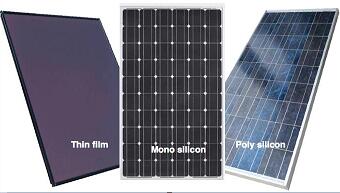Different types of solar panels
Mono crystalline silicon solar cells
Polycrystalline silicon solar cells
amorphous silicon solar cells
Multi-compound solar cells
How to select solar panels
(1) Mono crystalline silicon solar cells
Currently, the conversion efficiency of monocrystalline silicon solar cell is about 15% to a maximum of 24%, which is the highest in all kinds of photoelectric conversion efficiency of solar cells, but its production costs is too high to be used widely in most of conditions. As monocrystalline is usually encapsulated by silicon glass and waterproof resin, it is very rugged with service life in general up to 15 years, or even to 25 years.
(2) Polycrystalline silicon solar cells
The production process of Polycrystalline silicon solar cells is similar to Mono crystalline silicon solar cells, but the conversion efficiency of polycrystalline silicon solar cell is more less, the photoelectric conversion efficiency of poly crystalline is about 12% (in 2004). But the production cost is lower because the materials of the monocrystalline silicon solar cells is cheaper, the power consumption for production is less, so the total production costs is low, consequently it got more popular. However, the service life of polycrystalline silicon solar cells is also shorter than Mono crystalline silicon solar cells. The performance of single crystal silicon solar cells is also slightly better.

(3) Amorphous silicon solar cells
Amorphous silicon solar cells is a new thin film solar cells appeared in 1976, its production method is a totally different way with monocrystalline and polycrystalline silicon solar cells, the process is greatly simplified with little silicon material consumption and lower power consumption. its main advantage is it can generate electricity in low light conditions. But the main problem of amorphous silicon solar cells is that the conversion efficiency is low, the current international advanced level is 10%, and it is not stable enough, the conversion efficiency decay with time goes by.
(4) Multi-compound solar cells
Multi-compound solar cell refers to solar cells made of more than one single element of semiconductor materials. Nowadays, there are lots of studies worldwide, yet most of then have not been put into industrial production, mainly in the following categories:
a) CdS solar cell b) gallium arsenide solar cells c) copper indium selenide solar cells.

